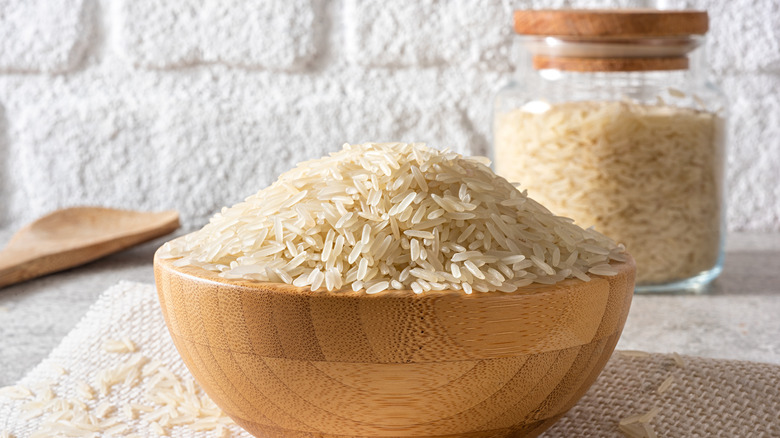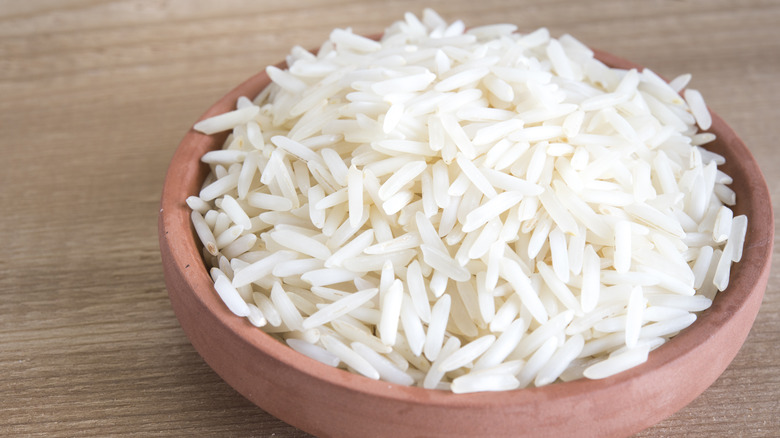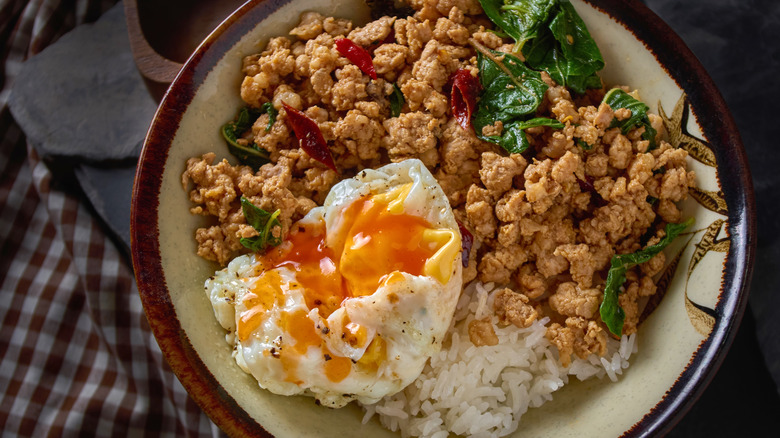Jasmine Vs White Rice: When To Use Each Variety
Rice is one of the most universal culinary cornerstones, consumed by well over 3 billion people every day. Predominantly grown in Asia, it's enjoyed across many continents, so unsurprisingly, it has spun off into many varieties. A particularly popular one is jasmine, a fragrant type grown in Southeast Asia and popular in South Asian and Middle Eastern cuisine.
You've likely noticed it on a grocery store shelf and might have wondered if it warrants any distinct uses in the kitchen. The short answer is yes — its airy consistency and gently nutty flavor make it perfect for flavorful soups, curries, and more. But how does it compare to that regular bag of white rice?
The distinction is a bit more complicated. Rather than signifying a variety, white rice refers to a processing type in which two rounds of milling and a polish remove the bran and germ. In fact, jasmine can be a type of white rice when handled in this manner, although it's also found in brown and black varieties. However, white rice comes in many more varieties, so it's important to know what's in the bag for optimal culinary use.
Match the white rice type with the culinary application
White rice may seem like a simple term, but it covers an incredible breadth of foods. For starters, there are over 40,000 cultivated rice strains, which are principally delineated into short, medium, and long-grain rice. Each of these categories includes white rice types, all with a distinct texture and accompanying starchiness. Understanding these qualities will help you know how to use them in the kitchen.
Long-grain varieties — which include jasmine and the even more aromatic basmati — are likely the first type that comes to mind. These are the perfect candidates for a basic stovetop steamed rice recipe, crafting a perfect side for dinner. Their grains easily separate, which makes them ideal in dishes like a delicious rice-based pilaf, as a vessel for sauces, or in a soup.
Meanwhile, medium-grain white rice offers a bit more starchiness. Many end up as the sticky variety on Korean and Chinese dining tables, while specifically Italian varieties are employed for risotto. Similarly, there's also the Spanish bomba, which is the white rice base you'll need for paella.
Some rice types fall on the smaller range of medium, blending into the final type — the short grain. This is the best rice for rice pudding, giving you the desired ultimate creaminess. And it's the tight-packed and sticky sushi rice that will ensure your roll won't fall apart.
Reach for jasmine rice when you're looking for an aromatic complement
Since jasmine rice is a specific variety, it comes with a much more defined culinary usage than other white rice types. Its kernels are long grain with a small starch content, which lends it a delightful fluffiness, with just a small amount of stickiness. To highlight such a texture, it's best to steam this rice, although it's fine to boil it in a pot as well. Especially when sourced high-quality, the flavor is gently sweet, nutty, and the grains may even smell a bit floral.
This aromatic nature makes the rice an ideal pairing with equally flavorful dishes. Serve jasmine alongside a curry, with coconut-based varieties pairing particularly well. It's frequently used in Thai cuisine, so just about any dish — whether it's a red curry, satay, or Thai basil beef — makes the perfect accompaniment. Just leave it out of fried rice; other varieties are better suited.
However, its texture is the perfect canvas for a stir fry, readily sopping up the flavorful sauce. In a similar vein, jasmine rice is a terrific accompaniment to a flavorful stew. Whether it's the Afro-Brazilian Moqueca seafood stew or Malaysian beef rendang, jasmine is the type you'll want for that slow-cooked goodness. Finally, don't overlook the less common brown and even rarer black jasmine types. These hulled varieties have an even more pronounced nutty flavor, ready to elevate a spiced Asian dish to the next level.


